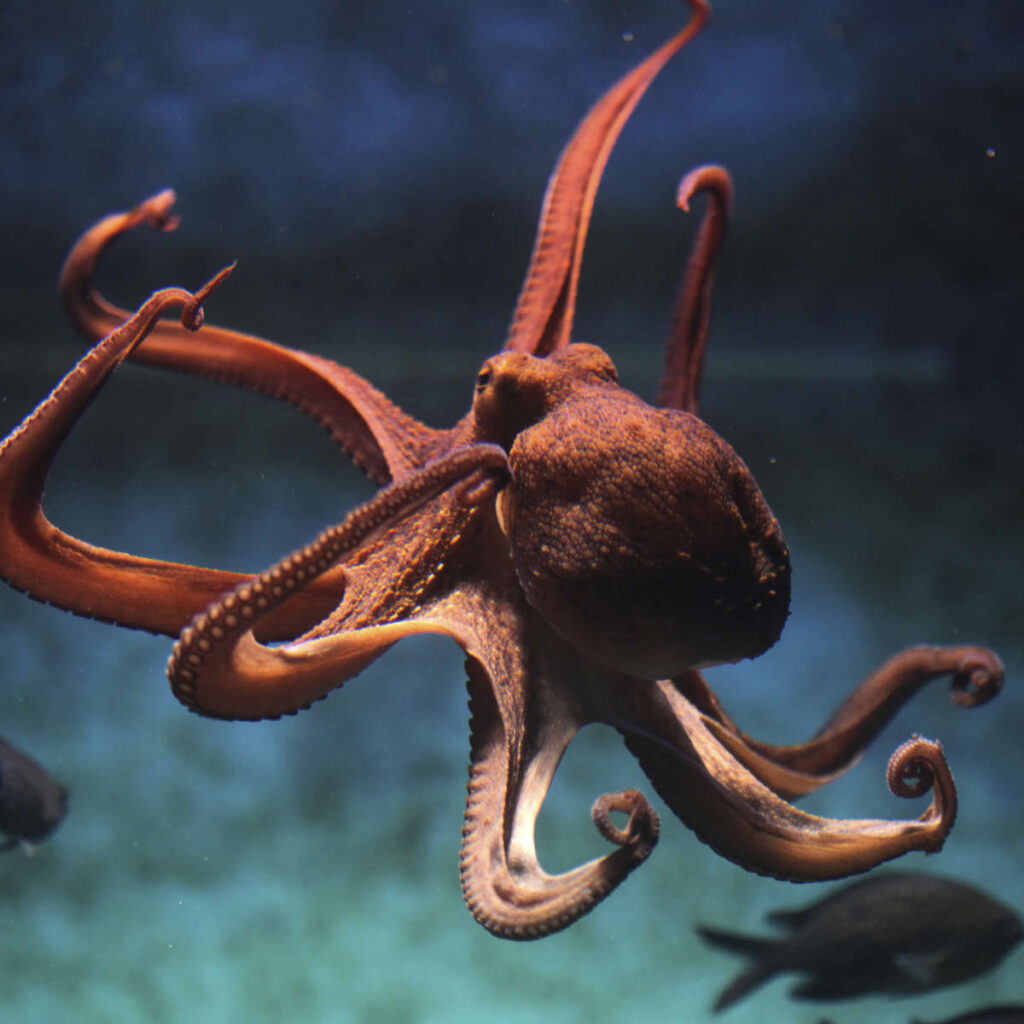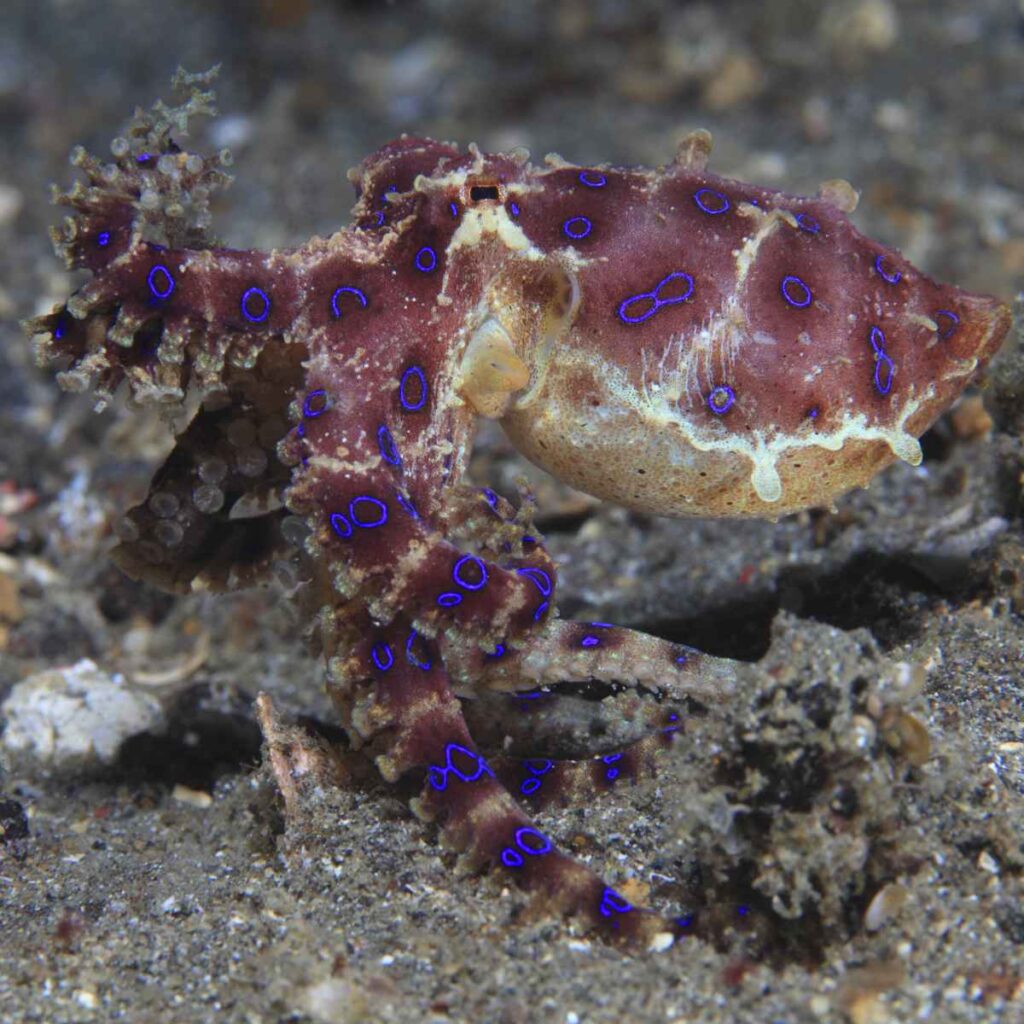Last Reviewed and Updated on July 3, 2022
Who doesn’t love a couple of good facts about octopuses? In this article, you’ll learn more about one of the most amazing creatures on our planet, a creature that can change its color, disguise itself and even use tools.
Some of the traits of octopuses even make them feel somewhat otherworldly.

1. All octopuses are venomous
Did you know that all octopuses are venomous? That’s right – every single one of them! Though most octopus species have venom that isn’t harmful to humans, there are a few exceptions. They have a special venom salivary gland that allows them to inject venom into their prey as they bite it.
2. The blue-ringed octopus’ venom is deadly
They may be one of the cutest octopuses as they are tiny and colorful but they have enough venom to kill multiple people (over 20) in a matter of minutes. They are one of the most poisonous marine animals. What’s even scarier is that their bites can be painless and people might not even realize they were bitten until symptoms kick in. It can lead to death within minutes if not treated.
They can be found in tide pools and coral reefs in the Pacific ocean and Indian ocean, from Japan to Australia. Luckily, this species is pretty docile and its first instinct when facing danger is to flee and not attack.

3. Their blood is blue-hued
The majority of animal species have red blood, however, octopuses do not. Their blood is blue. Pretty cool right? Our blood is iron-based (hemoglobin), which gives it the red color, and the blood of octopus is copper-based (hemocyanin) and this gives it its blue color. One of the coolest facts about octopuses for sure!
4. Octopuses have 3 hearts
Why settle with one if you can have 3? Not all of them have the same role either, two hearts pump the blood to the gills and one heart pumps the blood to the rest of its body.
5. They have been observed to use tools
Octopuses have been observed to use tools frequently. For example, they use coconut shells and use them as protective shielding when moving in exposed areas. They would use seashells for this as well.
6. They come in many sizes
When you think about an octopus, you usually have an orange-red baseball ball-sized animal in mind, but these creatures come in many sizes. From the likes of the most adorable Octopus wolfii which measures less than an inch / less than 2.5 cm to the likes of the Giant Pacific octopus which can measure up to 30 feet / 9 meters in length.
7. Octopuses live in saltwater only
There are no known species of octopus that would live in freshwater. They don’t tolerate freshwater. The body of an octopus would not handle the osmotic change in freshwater.
There have been some allegations of a freshwater octopus being observed in the rivers of North America. Some of the sightings proved to be a hoax. Sometimes people found dead octopuses, these were most likely sadly released from aquariums.
In theory, if an octopus-like creature existed in freshwater its physiology would be very different from that of an octopus.
8. They can regrow their limbs
One of the most fascinating facts about octopuses is that they can regrow their limbs. They aren’t as cool as some species of starfish that can grow an entirely new starfish from a severed limb, but being able to regrow a limb is still pretty cool.
When the male mates or when some of the species feel threatened, they can detach their own limbs.
9. Their reproduction has a deadly twist
This is one of the most bizarre facts about octopuses. Most octopuses only mate once, both females and males die soon after reproducing.
Once she lays the eggs, the female will quit eating and will waste away all while also protecting and caring for the eggs. By the time the eggs hatch she will die.
The male octopus will usually die within months of mating. They too stop feeding and they also become uncoordinated making them easy prey.
10. Octopuses can change color
They are (one of) the chameleons of the sea. They can change color because of chromatophores, special organs that are able to change color. These organs can be found throughout the skin of the octopus.
11. When threatened, most can squirt ink
They are cephalopods just like squid and it is normal to see them squirt ink if they are threatened. They will squirt ink to confuse and escape their predators. The ink is black or bluish-black.
The deep-sea octopuses (Cirrina) don’t have ink sacs so they do not produce (or squirt) ink.
12. Octopus are mostly solitary animals
This animal is notoriously solitary. But as with all things, there are exceptions to the rule. Scientists observed a species (Octopus tetricus) also living in a group.
13. They breathe through gills, like fish
Octopuses have gills that allow them to breathe underwater as fish do. They are not fish though, octopuses are marine mollusks, and they are closely related to squid, nautilus, and cuttlefish.
14. Octopus can survive on land for a short period of time
They need water to breathe but they can survive on land for short periods of time, ranging from a couple of minutes to almost half an hour.
Some are known to get out of the water, especially at night, to hunt for food on the shores.
15. They have beaks
When you think about beaks, birds are the first and usually the only animal that comes to mind. Octopus has beaks as well and if you look at it it is pretty similar to that of a bird (especially to that of a parrot). They are made differently though, the beak of a bird is made out of keratin and an octopus’s beak is made of chitin.
16. Octopuses can squeeze through tiny holes
Since they have no bones their body is very squeezable. The beak is the hardest part of their bodies so if the beak fits through the hole, so will the octopus.
